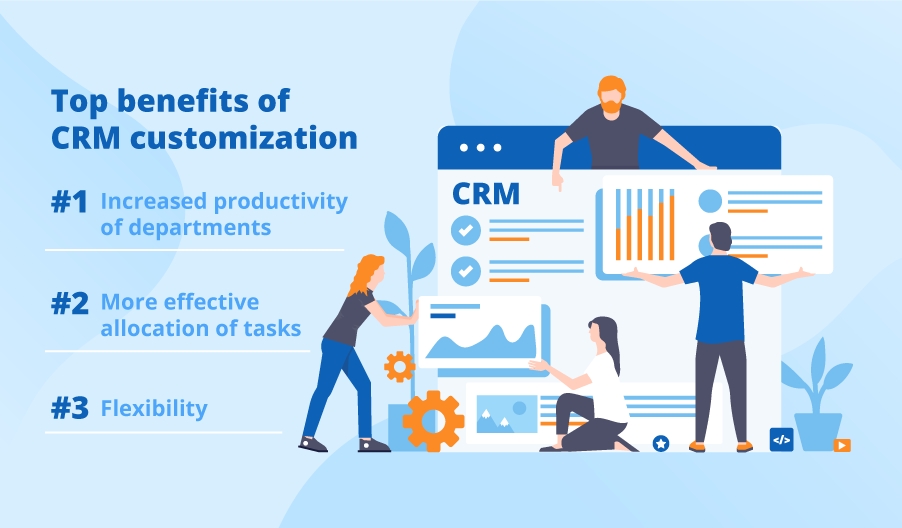Customer Relationship Management (CRM) systems are powerful tools designed to streamline sales, marketing, and customer service processes. However, the true value of a CRM lies in its ability to be customized to fit the unique needs of your business.
CRM customization allows you to tailor the software to your specific workflows, industry requirements, and organizational goals. By personalizing your CRM, you can enhance user adoption, improve data accuracy, and ultimately drive better business outcomes.
This article explores the key aspects of CRM customization, from understanding your business needs to implementing and maintaining a customized solution that truly enhances your operations.
CRM Customization: Tailor Your Software to Your Needs
CRM customization is a crucial aspect of modern business operations. By tailoring your Customer Relationship Management (CRM) software to your specific needs, you can enhance efficiency, improve customer satisfaction, and gain a competitive edge.
Customization allows you to integrate your unique business processes, data, and workflows into the CRM system, ensuring it perfectly aligns with your organizational goals and objectives.
Understanding the Importance of CRM Customization
Customizing your CRM is essential because it enables you to streamline processes and optimize workflows. A well-customized CRM can adapt to your specific business requirements, such as sales cycles, customer interactions, and service delivery.
This not only improves the usability of the software but also ensures that it provides the most relevant and actionable insights, leading to better decision-making and improved customer experiences.
Key Features of CRM Customization
When customizing your CRM, several key features can be tailored to fit your business needs. These include sales pipelines, customer service workflows, and reporting tools. By configuring these elements, you can create a more efficient and effective CRM system that aligns with your business processes.
Additionally, custom fields and forms allow you to capture and manage data that is specific to your industry, ensuring that your CRM remains a powerful tool for driving business growth.
Steps to Implement CRM Customization
To effectively implement CRM customization, follow these steps: assess your business needs, define your objectives, and plan the customization process. Begin by identifying the specific areas of your business that can benefit from customization.
Next, set clear and measurable goals for what you want to achieve with the customized CRM. Finally, work with a team of experts to execute the customization, ensuring that it is both functional and user-friendly. Regularly review and update the customization to keep it aligned with your evolving business needs.
| Customization Element | Description | Benefits |
|---|---|---|
| Sales Pipelines | Customized stages and processes for managing sales opportunities | Improved sales efficiency, better visibility of the sales process |
| Customer Service Workflows | Tailored processes for handling customer inquiries and issues | Enhanced customer satisfaction, faster issue resolution |
| Reporting Tools | Custom reports and dashboards for data analysis | Data-driven decision-making, actionable insights |
| Custom Fields and Forms | Additional data fields and forms for specific business needs | More comprehensive data management, tailored information capture |
How can businesses customize CRM systems to align with their unique needs and requirements?
.png)
Customizing a Customer Relationship Management (CRM) system is essential for businesses to maximize their efficiency and effectiveness. Here are several key strategies to align a CRM system with unique business needs and requirements:
1. Identify Key Business Objectives: The first step in customizing a CRM system is to clearly define your business objectives. This includes understanding what you want to achieve, such as improving customer service, streamlining sales processes, or enhancing marketing strategies. By identifying these objectives, you can tailor the CRM system to support these specific goals.
2. Conduct a Thorough Needs Assessment: Conduct a comprehensive needs assessment to understand the unique requirements of your business. This involves gathering input from various departments, such as sales, marketing, and customer service, to ensure that the CRM system meets the needs of all stakeholders. Tools like surveys, workshops, and interviews can be used to gather this information.
3. Customize User Interfaces and Workflows: Customize the user interface (UI) and workflows to match the way your business operates. This can include creating custom dashboards, forms, and reports that are tailored to the specific roles and responsibilities of your team members. For example, sales representatives might need a dashboard that shows real-time sales data, while customer service agents might need a tool to track customer interactions and issues.
4. Integrate with Other Systems: Integrate your CRM system with other business systems, such as ERP, marketing automation, and e-commerce platforms. This ensures that data flows seamlessly between systems, reducing the need for manual data entry and improving data accuracy. For instance, integrating your CRM with an ERP system can provide real-time inventory updates, while integration with a marketing automation platform can help in creating personalized customer journeys.
5. Utilize Advanced Features: Leverage advanced features and modules that align with your business needs. Many CRM systems offer additional modules for specific functions, such as sales forecasting, customer analytics, and social media integration. Evaluate which features are most relevant to your business and implement them to enhance functionality.
6. Train and Support Users: Provide comprehensive training and ongoing support to ensure that your team can effectively use the customized CRM system. This includes initial training sessions, user manuals, and ongoing support to address any questions or issues that arise. Well-trained users are more likely to adopt the system and use it to its full potential.
1. Customizing User Roles and Permissions
Customizing user roles and permissions is crucial for ensuring that each team member has access to the tools and data they need while maintaining security and compliance. Here’s how to approach this:
– Define Role-Specific Needs: Identify the specific tasks and responsibilities of each role within your organization. For example, a sales manager might need access to sales reports and team performance metrics, while a customer service representative might need access to customer interaction history and support tickets.
– Set Up Permission Levels: Create permission levels that align with each role. This can include read-only access, edit access, and full administrative access. Ensure that sensitive data is protected by restricting access to only those who need it.
– Regularly Review and Update: Regularly review and update user roles and permissions to reflect changes in responsibilities and organizational structure. This helps to maintain security and efficiency.
2. Tailoring CRM Data Fields and Forms
Tailoring CRM data fields and forms to capture the most relevant information is essential for accurate and useful data management. Here’s how to do so effectively:
– Conduct Data Analysis: Analyze the data you currently collect and identify any gaps or redundancies. Determine which data fields are most important for your business processes and customer relationships.
– Create Custom Fields: Add custom fields to capture specific information that is unique to your business. For example, if you are in the healthcare industry, you might need fields for patient medical history or insurance information.
– Simplify Data Entry: Simplify the data entry process by creating user-friendly forms with intuitive fields and clear instructions. This can improve data accuracy and reduce the time it takes to enter information.
3. Implementing Customized Reporting and Analytics
Implementing customized reporting and analytics helps businesses gain actionable insights and make data-driven decisions. Here’s how to customize reporting in your CRM system:
– Identify Key Metrics: Identify the key performance indicators (KPIs) that are most relevant to your business. This could include metrics like customer acquisition cost, customer lifetime value, and sales conversion rates.
– Create Custom Reports: Use the CRM system’s reporting tools to create custom reports that track these KPIs. Customize the reports to include the specific data and visualizations that are most useful for your team.
– Set Up Real-Time Dashboards: Set up real-time dashboards that provide at-a-glance insights into key metrics. This can help managers and team members stay informed and make timely decisions based on the latest data.
– Schedule Regular Reporting: Schedule regular reporting cycles to ensure that you are consistently monitoring and analyzing your data. This can help you identify trends, opportunities, and areas for improvement.
– Leverage AI and Machine Learning: If your CRM system offers AI and machine learning capabilities, leverage these tools to gain deeper insights and automate data analysis. For example, AI can help predict customer churn or identify the most effective sales strategies.
What is a good indicator of a CRM software’s customization capability?

A good indicator of a CRM software’s customization capability is its flexibility in adapting to specific business needs without requiring extensive coding or technical expertise. This includes the ability to modify user interfaces, workflows, and data fields to align with unique business processes and industry requirements.
A robust customization feature allows businesses to tailor the CRM to their exact specifications, enhancing usability and ensuring that the software supports all necessary functions. Here are three related subtopics:
1. User Interface Customization
User interface customization is a crucial aspect of a CRM’s flexibility. It allows users to modify the look and feel of the software to better match their brand and user experience preferences.
This can include changing the color scheme, adding company logos, and rearranging the layout of pages and dashboards. Such customization not only improves user satisfaction but also makes the CRM more intuitive and user-friendly.
- Brand Consistency: Ensures that the CRM aligns with the company’s visual identity.
- Custom Dashboards: Enables users to create personalized views of the most important information.
- Page Layouts: Allows for the rearrangement of fields and sections to match user workflows.
2. Workflow Automation
Workflow automation is another key indicator of a CRM’s customization capabilities. It involves the ability to create and modify automated processes that streamline tasks and improve efficiency.
Customizable workflows can trigger actions based on specific events, such as sending automated emails, updating contact statuses, or creating new tasks. This feature not only reduces manual work but also ensures that critical business processes are consistently followed.
- Event-Triggered Actions: Automates tasks based on predefined conditions or user actions.
- Customizable Rules: Allows users to set up complex business rules and conditions.
- Integration with Other Tools: Enables workflows to interact with external systems and apps.
3. Data Field Customization
Data field customization is essential for aligning the CRM with the specific data requirements of a business. It allows users to add, remove, or modify data fields to capture the information that is most relevant to their operations.
This can include creating custom fields for unique customer attributes, product details, or service information. Proper data field customization ensures that the CRM can store and manage all the necessary data for effective business management.
- Custom Fields: Adds fields for specific data points not covered by default.
- Data Validation: Ensures that the entered data meets certain criteria for accuracy.
- Field Types: Offers a variety of field types such as text, date, and dropdown menus.
What is customization in CRM?

Customization in CRM refers to the process of tailoring a Customer Relationship Management (CRM) system to meet the specific needs and requirements of a business.
This involves configuring various features, workflows, and user interfaces to align with the company’s unique processes, preferences, and industry standards. Customization can enhance user adoption, improve efficiency, and ensure that the CRM system provides the most value to the organization.
Benefits of CRM Customization
Customizing a CRM system can offer several benefits, including:
- Improved User Adoption: When a CRM system is tailored to the specific workflows and terminology used by a company, it becomes more intuitive for employees to use. This can lead to higher adoption rates and more consistent data input.
- Enhanced Efficiency: Customized workflows and automated processes can reduce manual tasks, minimize errors, and speed up operations. This can lead to faster response times and improved customer service.
- Greater Data Accuracy: By configuring the CRM to align with the company’s data management practices, it can help ensure that data is accurate, complete, and up-to-date. This, in turn, can improve decision-making and strategic planning.
Types of CRM Customization
There are several types of customizations that can be applied to a CRM system:
- Field Customization: Adding, removing, or modifying fields to better capture relevant data. This can include creating custom fields, setting data validation rules, and configuring field types.
- Workflows and Processes: Customizing business processes and workflows to match the company’s operational procedures. This can involve creating custom workflows, automating tasks, and setting up triggers and approvals.
- User Interface Customization: Tailoring the user interface to make it more user-friendly and relevant to the company’s needs. This can include customizing dashboards, reports, and navigation menus.
Challenges in CRM Customization
While customization can bring significant benefits, it also presents some challenges:
- Complexity and Cost: Customizing a CRM system can be a complex and resource-intensive process. It may require significant time and expertise to implement, and ongoing maintenance can add to the cost.
- Integration Issues: Customizing a CRM system can sometimes lead to integration issues with other business systems and applications. Ensuring seamless integration is crucial to avoid data discrepancies and operational inefficiencies.
- Training and Support: Users may need additional training to understand and effectively use the customized features. Providing adequate training and support is essential to maximize the benefits of customization.
What is the difference between CRM configuration and customization?
The difference between CRM configuration and customization lies in the level of modification and the technical expertise required. Configuration involves making changes to the default settings and features of a CRM system to align with a company’s specific needs without altering the core code.
Customization, on the other hand, involves making more extensive and often more complex changes, including modifying or adding new functionalities, which may require coding and integration with other systems.
1. Definition of CRM Configuration
CRM configuration refers to the process of adjusting and setting up the standard features and settings of a CRM system to match the business processes and requirements of an organization.
This can include setting up user roles, defining workflows, creating custom fields, and configuring reports and dashboards. Configuration is typically done using the CRM platform’s built-in tools and does not require extensive technical knowledge or coding skills.
- Setting up user roles and permissions to ensure data security and access control.
- Defining workflows to streamline sales and customer service processes.
- Creating custom fields to capture additional information relevant to the business.
2. Definition of CRM Customization
CRM customization involves making more significant and often more complex changes to the CRM system to meet unique business requirements that go beyond the capabilities of standard configuration.
This can include developing custom modules, integrating third-party applications, and writing custom scripts or code. Customization is typically performed by developers or IT professionals and requires a higher level of technical expertise.
- Developing custom modules to support specific business processes.
- Integrating third-party applications such as marketing automation tools or financial systems.
- Writing custom scripts or code to automate complex tasks and enhance functionality.
3. Key Differences Between Configuration and Customization
The key differences between CRM configuration and customization include the level of modification, the technical expertise required, and the potential impact on system maintenance and upgrades.
Configuration is generally less invasive and can be managed by business users, while customization often involves more complex changes that require specialized skills and can have a greater impact on system performance and future updates.
- Level of Modification: Configuration involves adjusting existing features, while customization involves creating new functionalities or modifying the core code.
- Technical Expertise: Configuration can be done by business users with basic training, whereas customization often requires developers or IT professionals with advanced technical skills.
- Impact on Maintenance and Upgrades: Configured systems are easier to maintain and update, while customized systems may require additional testing and adjustments to ensure compatibility with new releases.
Frequently Asked Questions
What is CRM Customization?
CRM Customization involves modifying and tailoring a Customer Relationship Management (CRM) system to align perfectly with your business processes and specific needs. This can include custom fields, workflows, and integrations, ensuring the CRM supports your unique operations and enhances efficiency.
Why is Customizing a CRM Important?
Customizing a CRM is crucial because it ensures the software meets your specific business requirements, improving user adoption and effectiveness. It allows for better data management, streamlined processes, and personalized customer interactions, ultimately leading to enhanced customer satisfaction and business growth.
Can I Integrate Third-Party Apps with a Customized CRM?
Yes, a customized CRM can be integrated with third-party apps and systems. This integration allows you to connect various tools and platforms, such as marketing automation, e-commerce, and customer service platforms, ensuring seamless data flow and operational efficiency.
How Much Does CRM Customization Cost?
The cost of CRM customization varies depending on the scale and complexity of the changes required. Factors include the number of custom features, integration needs, and ongoing support. It’s best to consult with a CRM provider or consultant to get a tailored quote based on your specific requirements.


